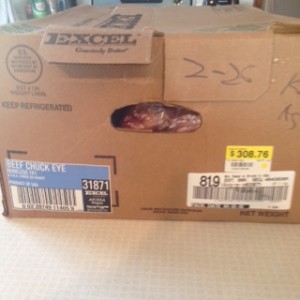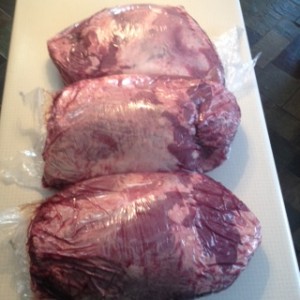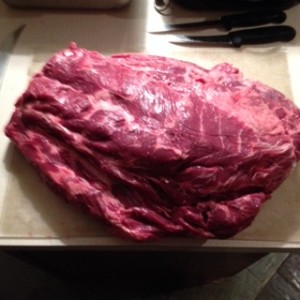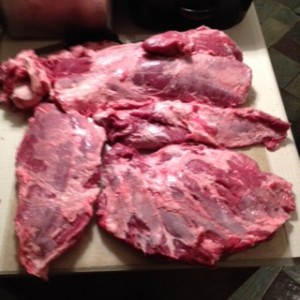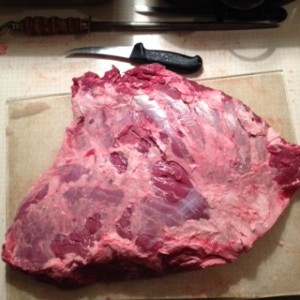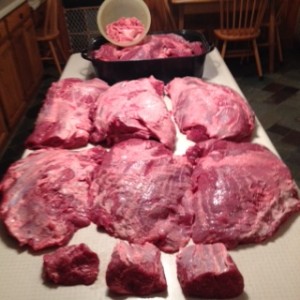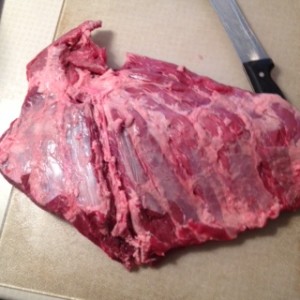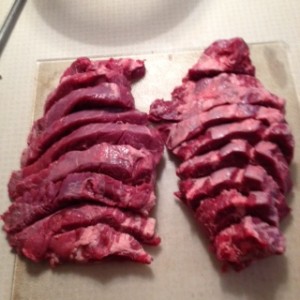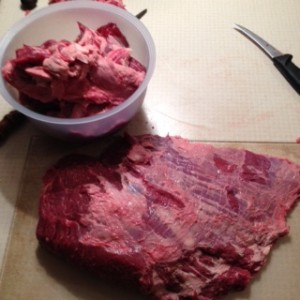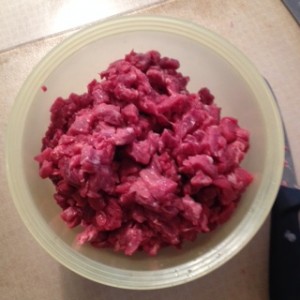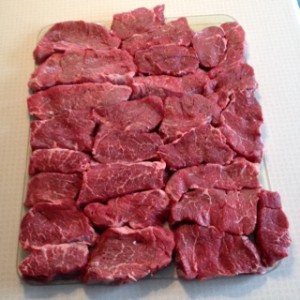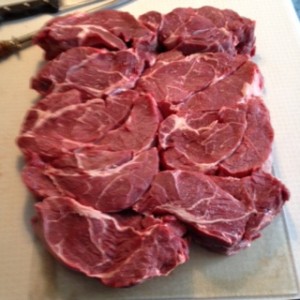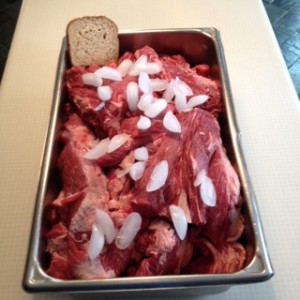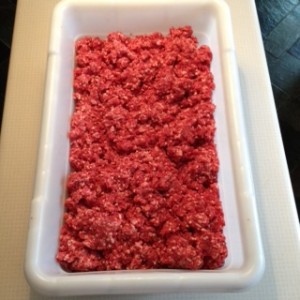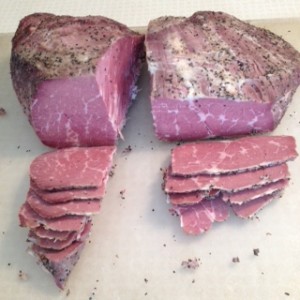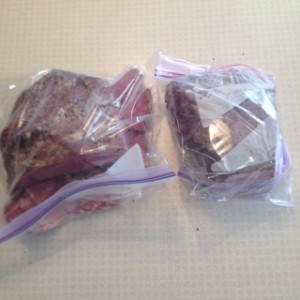Contrary to what the blue label above reads, the contents of the wholesale carton were Chuck Rolls; not solely Chuck-Eyes. As will be demonstrated later in this post, Chuck-Eyes are merely a section of Chuck Rolls. The price per pound I paid reflects wholesale club store prices available to the general public.
I believe that quite a few beef producers prefer selling big – lean market cattle so they can get paid more per unit and because all types of fat (marbling, muscle seams and subcutaneous) are expensive to put on young livestock. Unfortunately, too large rib-eye sizes makes it difficult to fabricate desired portion control steak weights in cut thickness that cook right and look eye appealing. Further, less grain-finished fat equates to less mild flavored beef and less cooked product juiciness.
It appears that when our current U.S. beef shortage started taking shape, around 2008 to 2010, that heavier weight cattle genetics were called into play as a means of getting more pounds of higher priced beef to market. I don’t know if this true or not, but when I picked up the Chuck Rolls used in this post the meat cutter told me that this 81.9 pound case was the lightest he had in stock. Another consequence of the bigger cattle now coming to market is that loins cut to desirable retail grocery thicknesses are very costly due to the combination of record high beef prices and large rib-eye sizes. While bigger cattle likely ain’t welcome news to steak buyers and sellers, larger – leaner market cattle do appear to be advantageous for Chuck Roll further processing. Such Chuck Rolls allow for the cutting of nice size chuck roasts from seamed-out Chuck Eyes, Denver steaks are better portion sizes and total useable trimmings are low enough in fat to be used to make Choice ground chuck in the 80 – 85% lean range. Since Chuck Rolls are considerably less expensive than “middle meats” (historically less in demand) home processors can still eat well at a fairly affordable price.
Not very many years ago one could buy whole Choice Chuck Rolls for around $2 per pound. Today, the cost of each of these 3 was right around $103.
One whole Chuck Roll ready to be separated along muscle seams. The seaming-out process is simple; there are plenty of videos and tutorials available online to assist a novice.
Same meat as the previous picture, but the Chuck Eye and under-blade have been seamed apart. The tapered end of the longissimus dorsi muscle (LD or rib-eye), appearing in the upper right of this picture on top of the Chuck Eye, was also separated out. Use high dry heat cookery on LD ends to eat them as rib-eye steak.
Here the Chuck Eye and LD end are shown again at the top, however the under-blade has been seamed apart to isolate the serratus ventralis muscle (lower right) from other under-blade muscles. The splenius muscle (lower left) could be used in either corned beef or smoke-cooked shredded beef production, but since it’s winter and I’m already making corned beef I opted to mix the 3 splenius muscles into Choice ground chuck. If you care to see methods to efficiently make versatile smoke-cooked shredded beef click here. And here. Chubs of beef shoulder chunks take about 1 1/2 hours longer, to cook tender, than does pork shoulder butts chunks.
Isolated serratus ventralis muscle.
From front to rear: tapered LD ends, serratus ventralis muscles, untrimmed Chuck Eyes, meat for Choice ground chuck in large roasting pan and objectionable materials (trim loss) in bowl.
Expose vein, then cut along its path to separate the serratus ventralis into 2 pieces that facilitates the cutting of Denver Steaks across the meat grain.
Separated serratus ventralis cut into Denver steaks.
One serratus ventralis was squared-up and saved for making corned beef.
Tapered edges of all 3 serratus ventralis muscles diced fairly fine for stir-fry meat. Packs of stir-fry meat can easily be made into smaller pieces of meat by knife slicing while still partially frozen. Microwave tempering works well for softening frozen packages enough to get a knife through. When cooking stir-fried dishes, I always put the meat in after vegies are almost as tender as desired so the beef does not overcook.
Denver steaks from 2 serratus ventralis muscles. Denver steaks are not the most tender or uniform cutting steaks in the world; I like to grill them then slice thin for salad topping. Using thin slices of this tasty cut on salads or in fajitas etc. also increases the number of meals that a family can eat from a given amount of steak.
A 6 pound serratus ventralis cure pumped with about 3 1/2 cups of water, 2 1/4 tsp. of sodium phosphate, 1 slightly heaping tsp. of cure #1, 2 3/4 Tbsp. purified salt, 1 3/4 Tbsp. brown sugar and a pinch of sodium erythorbate. Additionally, crushed garlic and coarse ground black pepper were boiled in a small amount of water; then chilled to pour over the roast’s exterior. In order to allow adequate time for good non-meat ingredient distribution, the roast was held in refrigeration and turned twice a day for 2 days prior to low heat steam cooking as corned beef.
9 thick, center-cut Chuck Eye roast. If we run out of Choice ground chuck next summer, and don’t feel like cooking chuck roast (more of a winter thing), I can quickly run a roast through my hand-crank back-up grinder. Or, I could chunk chuck roasts and smoke-cook them in large fibrous casings to produce versatile smoke-cooked shredded beef.
Meat to make hard to obtain Choice ground chuck. I carefully look over and trim the surface of Chuck Rolls so we can feel semi-comfortable eating ground beef that is cooked to the 140F range (more juicy and flavorful). So far I have found bone-fragments to be non-existent on Chuck Rolls, but sometimes there is some bone-skin off the shoulder blade that needs to be removed. There’s no comparison between thick muscle Choice ground chuck and store bought grinds; that most often contain mainly culled beef brood & dairy cow meat.
On the way to the grinder with a little ice to facilitate grinding and frozen bread to push most of the meat out of the grinder’s head, after the last of the meat has passed through.
Hand mixed 80% plus lean Choice ground chuck; ground once through a 3/16 inch hole-size plate.
All product from the wholesale case (except the roast cured for corned beef) heading for the freezer where it was spread out in a single layer to freeze quickly. Most air was occluded prior to sealing the primary container (small plastic bags) and gallon size zip-lock bags were used to provide a secondary air and moisture impermeable wrap.
Roast was kept up out of cooking purge by rack and was cooked covered at 170F for 4 hours to reach 155F internal. Although this product was injected, 155F is food safe because of the dwell time at that temperature; the use of cure also helps inhibit bacterial growth. Hitting the 160F internal (in a products cold-spot) benchmark requires no dwell time. This cut is both more tender and less expensive than the BBQ craze driven brisket. Perhaps the current brisket situation will bring about the creation of a serratus ventralis (better name needed) category on the completion BBQ circuit.
Corned beef roast was cut in half along the vein line to facilitate slicing across the meat grain. End pieces are good for dicing up as salad topping or to use in making corned beef hash.
Half was double wrapped and placed in freezer storage, the other is for eating out of refrigeration in the near term.
Summary:
Case weighed 81.9 pounds X $3.77 per pound = $308.76
Case weight of 81.9 pounds – 1 1/4 pounds of trim loss & bag purge = 80.65 pounds of usable product.
$308.76 wholesale carton price divided by 80.65 pounds of usable raw product = $3.83 per pound.
1 1/2 pounds of tapered LD ends divided by 80.65 pounds = 1.86%
10 pounds of Denver steaks divided by 80.65 pounds = 12.42%
6 pounds of serratus ventralis for corned beef divided by 80.65 pounds = 7.45%
3 1/2 pounds of serratus ventralis tapered edges for stir-fry divided by 80.65 = 4.3%
18 1/2 pounds of thick Chuck Eye roast divided by 80.65 = 22.94%
80.65 of usable product – 39.5 pounds previously accounted for = 41.15 pounds
41.15 pounds of Choice ground chuck divided by 80.65 = 51.03%
Note: the 3 different serratus ventralis cuts totaled 24.17%

